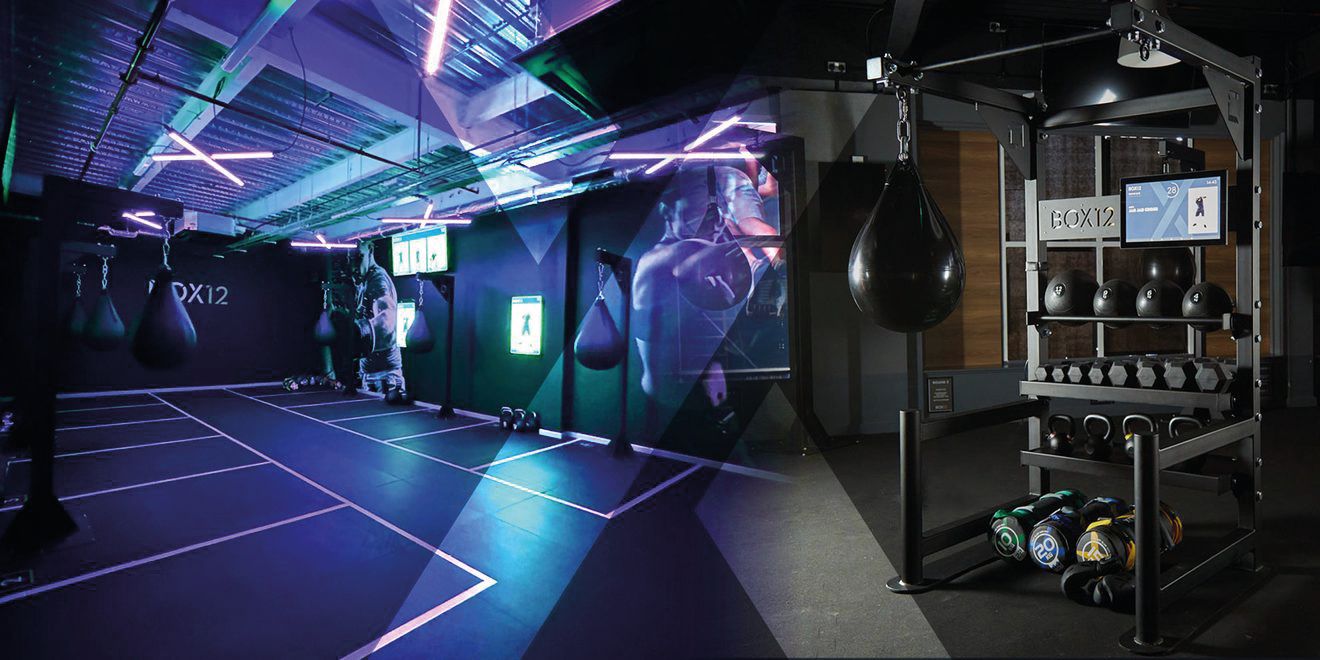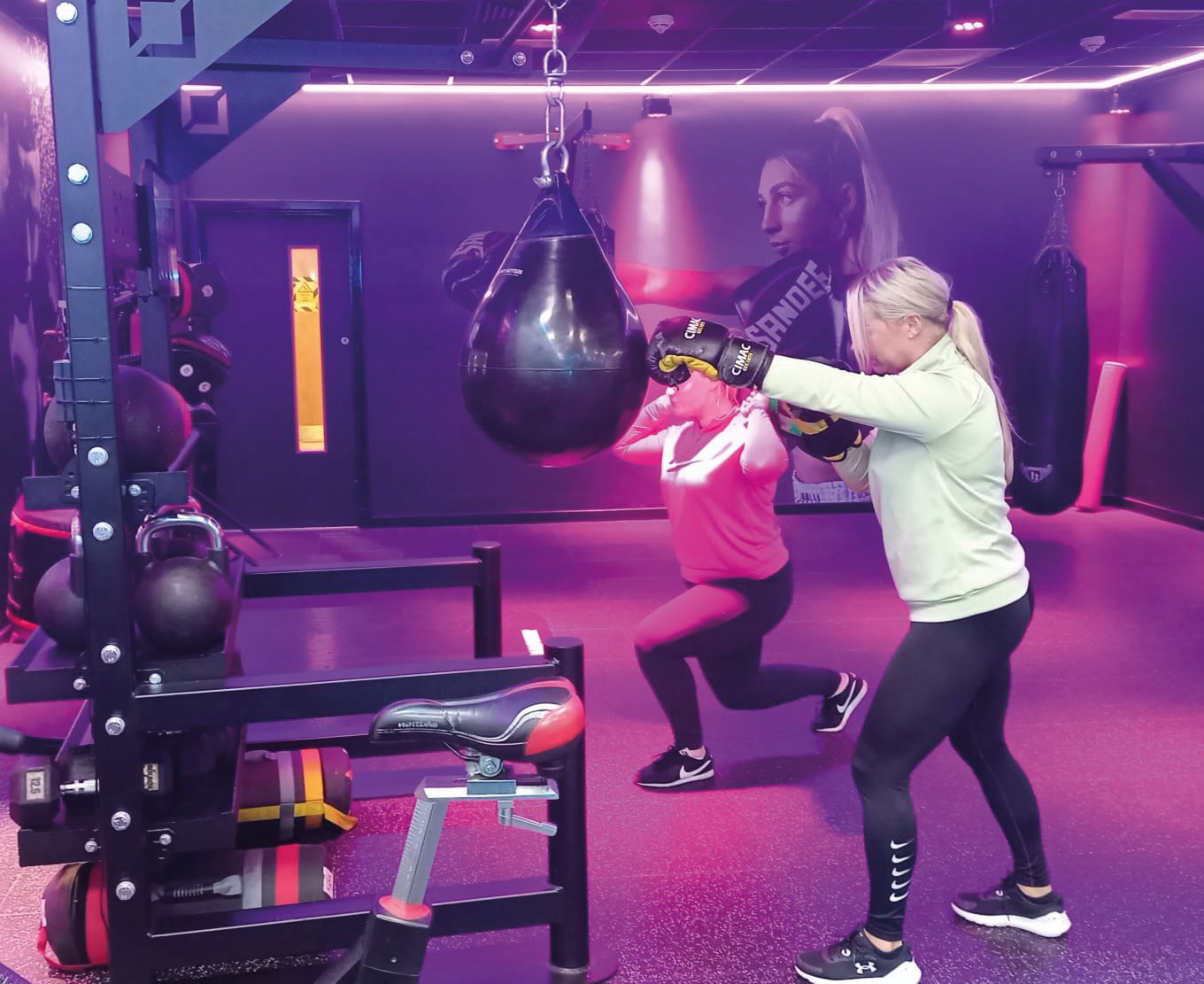
Combat fitness – with boxing at its core – has seen a remarkable surge in popularity in gymsand leisure centres in recent years, with boxing fitness becoming a staple offering foroperators looking to attract
THE clang of gloves hitting pads, the rhythmic thud of feet shuffling on mats and the infectious energy of a trainer shouting encouragement: these are the unmistakable sounds of a boxing session in full swing. Once considered the domain of professional fighters and underground gyms, boxing has made its way into the mainstream fitness world in the UK – and it’s here to stay. Over the last decade, combat fitness – with boxing at its core - has experienced are markable surge in popularity. Gyms that once focused on treadmills and weight machines now dedicate entire spaces to punch bags, speed balls and tech-based studios. Group classes like boxercise, and high-intensity interval workouts inspired by boxing routines, are drawing in participants.
The appeal of boxing
So why has boxing become such a knockout success in the fitness world? One key factor is its versatility. Boxing offers a full-body workout that combines cardio, strength and coordination, making it ideal for those looking to improve their overall fitness. Unlike running on a treadmill or lifting weights, it engages both the body and the mind, requiring focus, strategy and quickthinking. It’s a sport where technique matters as much as effort and that dual challenge appeals to many. Another major draw is the empowerment it provides. Boxing builds confidence, not just from mastering techniques but also from the sheer catharsis of throwing punches. For many, it’s as much about stress relief as it is about fitness. The mental health benefits are significant; boxing allows people to channel their frustrations into something productive, leaving them physically exhausted but mentally rejuvenated. Social media has also played a significant role in boxing’s newfound fame. Influencers and celebrities regularly post about their boxing workouts. From model Gigi Hadid to actor Tom Hardy, boxing has become a go-to workout for the stars, inspiring their followers to try it out at their local gym.
From sparring rings to fitness classes
The shift from traditional boxing gyms to mainstream fitness centres has been pivotal in the sport’s rising popularity. Big-name chains like Virgin Active, Les Mills and David Lloyd now offer boxing-inspired classes, and boutique studios specialising in combat fitness are flourishing. These spaces are designed to be inclusive, welcoming everyone from seasoned athletes to complete beginners. The move from boxing clubs into gyms can be traced back to 1992, when Boxercise, a blend of boxing and exercise, was founded by professional boxing coach Andy Wake. The concept began as a club for students and was initially started to raise funds to buy equipment for the fledgeling Brunel University Boxing Club. The classes quickly became popular with participants wanting to enjoy the benefits of boxing training but without getting hit back. Soon, other fitness trainers approached Wake to train them and the courses were born. Boxercise’s structured format, featuring pad work, shadow boxing and circuit training, means it can be scaled for group classes, and its rapid adoption across gyms in the UK solidified its reputation as a versatile and effective workout. By the mid-2000s, Boxercise was a staple in gyms and fitness centres across the UK, while its certification programmes for instructors helped standardise the training methodology and expand its reach. It’s now present in 56 countries worldwide, with the online courses translated into 11 languages. Wake explains: ‘The original concept began purely as punching only, but quickly theKick Boxercise element was added due to demand in the late 1990's. Then we introduced Boxercise for Kids and Parkinson's Boxercise. We are currently working on a new kids Boxercise programme, which we expect to launch in September.’The company has recently partnered with The Fitness Group, the UK’s leading fitness education provider to provide online and in-person courses for fitness professionals, to help them upskill and deliver greater value and push standards higher. ‘This will be of great benefit to the fitness industry because there are some unscrupulous people using AI to make fake certificates,’ Wake says. ‘The public can't easily check that a PT or class instructor is qualified and insured, but they can check on our website if an instructor is qualified in a few seconds so they can feel safe. The benefit to ourselves is the excellent quality of graduates from The Fitness Group coming into our courses. ’Steven, co-founder and director at The Fitness Group, agrees that the move was needed in light of the increasing popularity of the sport: ‘We came together because we both share a mission to improve the education standards for the sector, continuing to ensure that people wanting to begin a career in the fitness industry – or current fitness professionals upskilling – are given the very best education.’
Technology meets tradition
The rise of combat fitness has been further amplified by technology. Wearable fitness trackers and apps now offer boxing-specific features, helping participants monitor their punch count, speed and intensity. Unique to the sector is BOX12, which was founded in 2019 by industry veterans Jamie Cartwright and Jon Eade. Cartwright had previously launched a multi-site, women-only circuit gym chain, while Eade had built a boxing for fitness training academy in collaboration with four-time world champion Ricky Hatton. This combination of hands-on fitness experience and expertise in boxing led themto create BOX12 – a scalable solution designed to help gym operators engage more consumers into boxing fitness. BOX12 products include The Pod, a tech-led boxing and functional fitness pod, designed as a stand alone piece of kit with a screen and a hanging bag. It is aimed at operators who want an on-demand solution but have limited space. By contrast, the club-in-club studio system requires around 53m2 and provides 24/7 individual circuits and group workouts powered by virtual coaching screens. Joanna Walker has been chief marketing officer for BOX12 since September of last year and says both products not only offer the benefits of boxing, but the flexibility that users now require – arguably one of the biggest trends this year.


‘Flexibility is a hot topic of conversation and operators are asking how they can serveconsumers in terms of working aroundcustomers’ schedules’, she says. ‘We’reseeing a lot of operators move into to 24/7models now. What’s great about the club-in-club studio is that it can be used to fit aroundpeople's schedules rather than having tocommit to rigid class timetables.‘BOX12 enables members to just turn up at the gym, get a full body workout in 36 minutes using a guided training circuit via digital screens at any time that suits. The studio is the size of a squash court and offers an immersive experience, with a dark industrial look and low lighting – it’s a very boutique experience.
Attracting a diverse audience
Whether it’s through one-on-one training msessions or group classes, boxing fitness also has the capacity to create a supportive and motivational atmosphere. This camaraderie keeps people coming back, transforming what might have been a short-term fitness experiment into a long-term passion. Walker agrees that boxing fitness lends itself perfectly to this aspect of the sport: ‘It’s highly accessible to diverse ranges of people. We have a menopause programme that’s a perfect example, while we have other operators that are using it to support disadvantaged youths within their community and under 16s. Boxing fitness is the perfect workout experience for younger people because it's guided and they love punching the bags. The pod also allows wheelchair users to get a really good workout.’
Challenges and opportunities
Despite its growing popularity, combat fitness still faces challenges. The physical intensity can be intimidating for new comers, and the sport’s historical association with violence still lingers in some perceptions. However, gyms and trainers are working to dispel these notions by emphasising safety, technique and the inclusive nature of modern boxing fitness, as well as the physical and mental benefits. Looking ahead, the future in the UK looks bright. The integration of boxing into the broader fitness culture, combined with its adaptability and universal appeal, ensures it will continue to attract new participants. As gyms innovate further – blending tradition with technology and catering to diverse audiences – the activity is set to remain one of the most dynamic and engaging fitness trends for years to come. As Walker says: ‘The health benefits of boxing are not just around the physical –you’ve also got the stress busting element, the confidence boosting and the sense of empowerment. The perception is often, okay, it's just a boxing pod, but boxing fitness is actually so much more than that, and we need to make sure we get that message across. It’s also really fun!